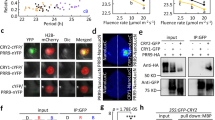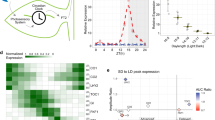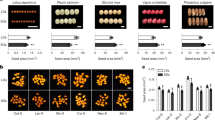Abstract
Several organisms have evolved the ability to measure daylength, or photoperiod, allowing them to adjust their development in anticipation of annual seasonal changes. Daylength measurement requires the integration of temporal information, provided by the circadian system, with light/dark discrimination, initiated by specific photoreceptors. Here we demonstrate that in Arabidopsis this integration takes place at the level of CONSTANS (CO)1 function. CO is a transcriptional activator that accelerates flowering time in long days, at least in part by inducing the expression of FLOWERING LOCUS T (FT)2,3,4,5. First, we show that precise clock control of the timing of CO expression, such that it is high during daytime only in long days, is critical for daylength discrimination. We then provide evidence that CO activation of FT expression requires the presence of light perceived through cryptochrome 2 (cry2) or phytochrome A (phyA). We conclude that an external coincidence mechanism, based on the endogenous circadian control of CO messenger RNA levels, and the modulation of CO function by light, constitutes the molecular basis for the regulation of flowering time by daylength in Arabidopsis.
This is a preview of subscription content, access via your institution
Access options
Subscribe to this journal
Receive 51 print issues and online access
$199.00 per year
only $3.90 per issue
Buy this article
- Purchase on Springer Link
- Instant access to full article PDF
Prices may be subject to local taxes which are calculated during checkout





Similar content being viewed by others
References
Putterill, J., Robson, F., Lee, K., Simon, R. & Coupland, G. The CONSTANS gene of Arabidopsis promotes flowering and encodes a protein showing similarities to zinc finger transcription factors. Cell 80, 847–857 (1995)
Samach, A. et al. Distinct role of CONSTANS target genes in reproductive development of Arabidopsis. Science 288, 1613–1616 (2000)
Kardailsky, I. et al. Activation tagging of the floral inducer FT. Science 286, 1962–1965 (1999)
Onouchi, H., Igeno, M. I., Perilleux, C., Graves, K. & Coupland, G. Mutagenesis of plants overexpressing CONSTANS demonstrates novel interactions among Arabidopsis flowering-time genes. Plant Cell 12, 885–900 (2000)
Kobayashi, Y., Kaya, H., Goto, K., Iwabuchi, M. & Araki, T. A pair of related genes with antagonistic roles in mediating flowering signals. Science 286, 1960–1962 (1999)
Samach, A. & Coupland, G. Time measurement and the control of flowering in plants. Bioessays 22, 38–47 (2000)
Suarez-Lopez, P. et al. CONSTANS mediates between the circadian clock and the control of flowering in Arabidopsis. Nature 410, 1116–1120 (2001)
Schaffer, R. et al. The late elongated hypocotyl mutation of Arabidopsis disrupts circadian rhythms and the photoperiodic control of flowering. Cell 93, 1219–1229 (1998)
Hicks, K. A. et al. Conditional circadian dysfunction of the Arabidopsis early-flowering 3 mutant. Science 274, 790–792 (1996)
Park, D. et al. Control of circadian rhythms and photoperiodic flowering by the Arabidopsis GIGANTEA gene. Science 285, 1579–1582 (1999)
Zagotta, M. T. et al. The Arabidopsis ELF3 gene regulates vegetative photomorphogenesis and the photoperiodic induction of flowering. Plant J. 10, 691–702 (1996)
Araki, T. & Komeda, Y. Analysis of the role of the late-flowering locus, GI, in the flowering of Arabidopsis thaliana. Plant J. 3, 231–239 (1993)
Huq, E., Tepperman, J. M. & Quail, P. H. GIGANTEA is a nuclear protein involved in phytochrome signaling in Arabidopsis. Proc. Natl Acad. Sci. USA 97, 9789–9794 (2000)
Strayer, C. et al. Cloning of the Arabidopsis clock gene TOC1, an autoregulatory response regulator homolog. Science 289, 768–771 (2000)
Somers, D. E., Webb, A. A. R., Pearson, M. & Kay, S. The short-period mutant, toc1-1, alters circadian clock regulation of multiple outputs throughout development in Arabidopsis thaliana. Development 125, 485–494 (1998)
Millar, A. J., Carré, I. A., Strayer, C. A., Chua, N.-H. & Kay, S. A. Circadian clock mutants in Arabidopsis identified by luciferase imaging. Science 267, 1161–1163 (1995)
Alabadi, D. et al. Reciprocal regulation between TOC1 and LHY/CCA1 within the Arabidopsis circadian clock. Science 293, 880–883 (2001)
Guo, H. W., Yang, W. Y., Mockler, T. C. & Lin, C. T. Regulation of flowering time by Arabidopsis photoreceptors. Science 279, 1360–1363 (1998)
Johnson, E., Bradley, M., Harberd, N. P. & Whitelam, G. C. Photoresponses of light-grown phyA mutants of Arabidopsis. Phytochrome A is required for the perception of daylength extensions. Plant Physiol. 105, 141–149 (1994)
Corbesier, L., Gadisseur, I., Silvestre, G., Jacqmard, A. & Bernier, G. Design in Arabidopsis of a synchronous system of floral induction by one long day. Plant J. 9, 947–952 (1996)
Bünning, E. Die endogene Tagesrhthmik als Grundlage der photoperiodischen Reaktion. Ber. Dtsch Bot. Ges. 54, 590–607 (1936)
Pittendrigh, C. S. & Minis, D. H. The entrainment of circadian oscillations by light and their role as photoperiodic clocks. Am. Nat. 98, 261–294 (1964)
Pittendrigh, C. S. Circadian rhythms and the circadian organization of living systems. Cold Spring Harbor Symp. Quant. Biol. 25, 159–184 (1960)
Yanovsky, M. J. & Kay, S. A. Signaling networks in the plant circadian system. Curr. Opin. Plant Biol. 4, 429–435 (2001)
Blazquez, M. A. & Weigel, D. Independent regulation of flowering by phytochrome B and gibberellins in Arabidopsis. Plant Physiol. 120, 1025–1032 (1999)
Acknowledgements
We thank J. J. Casal, S. Harmer, P. Mas and F. Harmon for critical reading of the manuscript. This work was supported by an NIH grant to S.A.K. The work of M.J.Y. was initially supported by Conicet, Antorchas and the University of Buenos Aires and, more recently, by the Pew Foundation.
Author information
Authors and Affiliations
Corresponding author
Ethics declarations
Competing interests
The authors declare that they have no competing financial interests.
Rights and permissions
About this article
Cite this article
Yanovsky, M., Kay, S. Molecular basis of seasonal time measurement in Arabidopsis. Nature 419, 308–312 (2002). https://doi.org/10.1038/nature00996
Received:
Accepted:
Issue Date:
DOI: https://doi.org/10.1038/nature00996
This article is cited by
-
Core clock genes adjust growth cessation time to day-night switches in poplar
Nature Communications (2024)
-
Common evolutionary trajectory of short life-cycle in Brassicaceae ruderal weeds
Nature Communications (2023)
-
Overexpression of the Liriodendron chinense CONSTANS gene in Arabidopsis causes earlier flowering under long-day conditions
Plant Growth Regulation (2023)
-
CRY2 interacts with CIS1 to regulate thermosensory flowering via FLM alternative splicing
Nature Communications (2022)
-
Environment-mediated mutagenetic interference on genetic stabilization and circadian rhythm in plants
Cellular and Molecular Life Sciences (2022)
Comments
By submitting a comment you agree to abide by our Terms and Community Guidelines. If you find something abusive or that does not comply with our terms or guidelines please flag it as inappropriate.



